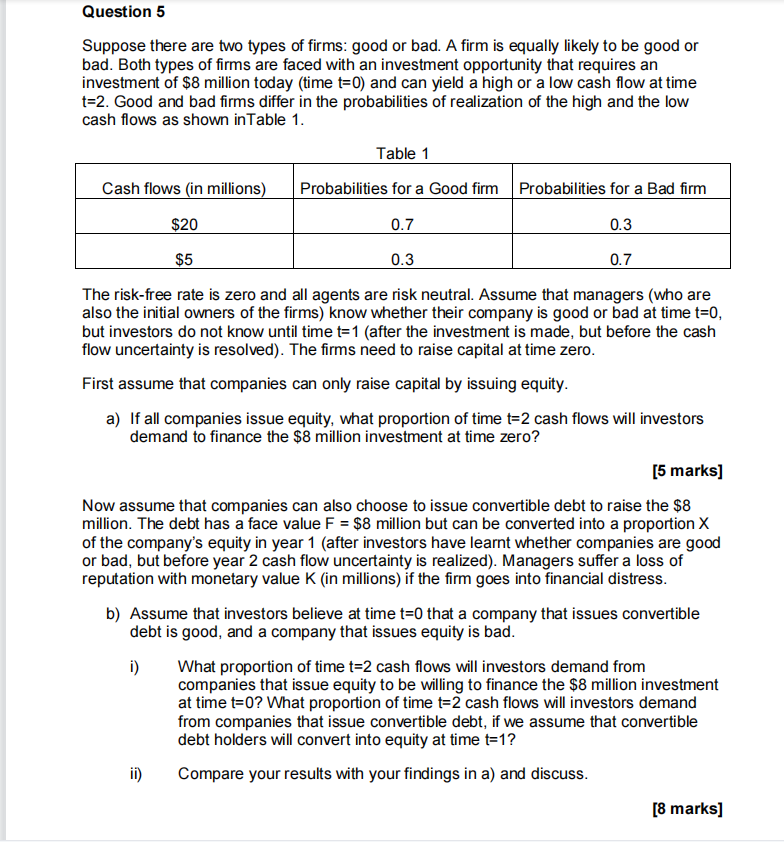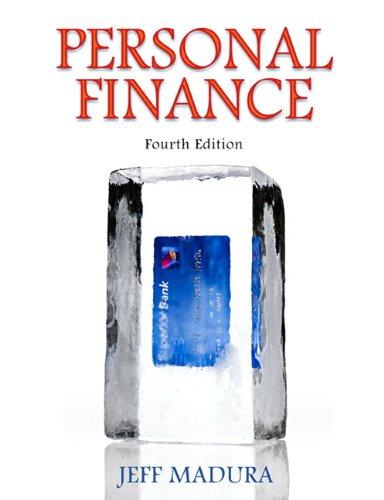
Question 5 Suppose there are two types of firms: good or bad. A firm is equally likely to be good or bad. Both types of firms are faced with an investment opportunity that requires an investment of $8 million today (time t=0) and can yield a high or a low cash flow at time t=2. Good and bad firms differ in the probabilities of realization of the high and the low cash flows as shown in Table 1. Table 1 Cash flows (in millions) Probabilities for a Good firm Probabilities for a Bad firm $20 0.7 0.3 $5 0.3 0.7 The risk-free rate is zero and all agents are risk neutral. Assume that managers (who are also the initial owners of the firms) know whether their company is good or bad at time t=0, but investors do not know until time t=1 (after the investment is made, but before the cash flow uncertainty is resolved). The firms need to raise capital at time zero. First assume that companies can only raise capital by issuing equity. a) If all companies issue equity, what proportion of time t=2 cash flows will investors demand to finance the $8 million investment at time zero? [5 marks] Now assume that companies can also choose to issue convertible debt to raise the $8 million. The debt has a face value F = $8 million but can be converted into a proportion X of the company's equity in year 1 (after investors have learnt whether companies are good or bad, but before year 2 cash flow uncertainty is realized). Managers suffer a loss of reputation with monetary value K (in millions) if the firm goes into financial distress. b) Assume that investors believe at time t=0 that a company that issues convertible debt is good, and a company that issues equity is bad. i) What proportion of time t=2 cash flows will investors demand from companies that issue equity to be willing to finance the $8 million investment at time t=0? What proportion of time t=2 cash flows will investors demand from companies that issue convertible debt, if we assume that convertible debt holders will convert into equity at time t=1? Compare your results with your findings in a) and discuss. [8 marks] Question 5 Suppose there are two types of firms: good or bad. A firm is equally likely to be good or bad. Both types of firms are faced with an investment opportunity that requires an investment of $8 million today (time t=0) and can yield a high or a low cash flow at time t=2. Good and bad firms differ in the probabilities of realization of the high and the low cash flows as shown in Table 1. Table 1 Cash flows (in millions) Probabilities for a Good firm Probabilities for a Bad firm $20 0.7 0.3 $5 0.3 0.7 The risk-free rate is zero and all agents are risk neutral. Assume that managers (who are also the initial owners of the firms) know whether their company is good or bad at time t=0, but investors do not know until time t=1 (after the investment is made, but before the cash flow uncertainty is resolved). The firms need to raise capital at time zero. First assume that companies can only raise capital by issuing equity. a) If all companies issue equity, what proportion of time t=2 cash flows will investors demand to finance the $8 million investment at time zero? [5 marks] Now assume that companies can also choose to issue convertible debt to raise the $8 million. The debt has a face value F = $8 million but can be converted into a proportion X of the company's equity in year 1 (after investors have learnt whether companies are good or bad, but before year 2 cash flow uncertainty is realized). Managers suffer a loss of reputation with monetary value K (in millions) if the firm goes into financial distress. b) Assume that investors believe at time t=0 that a company that issues convertible debt is good, and a company that issues equity is bad. i) What proportion of time t=2 cash flows will investors demand from companies that issue equity to be willing to finance the $8 million investment at time t=0? What proportion of time t=2 cash flows will investors demand from companies that issue convertible debt, if we assume that convertible debt holders will convert into equity at time t=1? Compare your results with your findings in a) and discuss. [8 marks]







